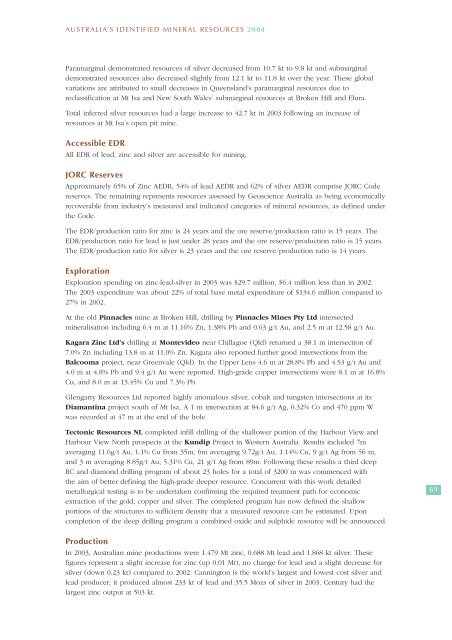australia's identified mineral resources 2004 - Geoscience Australia
australia's identified mineral resources 2004 - Geoscience Australia
australia's identified mineral resources 2004 - Geoscience Australia
Create successful ePaper yourself
Turn your PDF publications into a flip-book with our unique Google optimized e-Paper software.
AUSTRALIA’S IDENTIFIED MINERAL RESOURCES <strong>2004</strong><br />
Paramarginal demonstrated <strong>resources</strong> of silver decreased from 10.7 kt to 9.8 kt and submarginal<br />
demonstrated <strong>resources</strong> also decreased slightly from 12.1 kt to 11.8 kt over the year. These global<br />
variations are attributed to small decreases in Queensland’s paramarginal <strong>resources</strong> due to<br />
reclassification at Mt Isa and New South Wales’ submarginal <strong>resources</strong> at Broken Hill and Elura.<br />
Total inferred silver <strong>resources</strong> had a large increase to 42.7 kt in 2003 following an increase of<br />
<strong>resources</strong> at Mt Isa’s open pit mine.<br />
Accessible EDR<br />
All EDR of lead, zinc and silver are accessible for mining.<br />
JORC Reserves<br />
Approximately 65% of Zinc AEDR, 54% of lead AEDR and 62% of silver AEDR comprise JORC Code<br />
reserves. The remaining represents <strong>resources</strong> assessed by <strong>Geoscience</strong> <strong>Australia</strong> as being economically<br />
recoverable from industry’s measured and indicated categories of <strong>mineral</strong> <strong>resources</strong>, as defined under<br />
the Code.<br />
The EDR/production ratio for zinc is 24 years and the ore reserve/production ratio is 15 years. The<br />
EDR/production ratio for lead is just under 28 years and the ore reserve/production ratio is 15 years.<br />
The EDR/production ratio for silver is 23 years and the ore reserve/production ratio is 14 years.<br />
Exploration<br />
Exploration spending on zinc-lead-silver in 2003 was $29.7 million, $6.4 million less than in 2002.<br />
The 2003 expenditure was about 22% of total base metal expenditure of $134.6 million compared to<br />
27% in 2002.<br />
At the old Pinnacles mine at Broken Hill, drilling by Pinnacles Mines Pty Ltd intersected<br />
<strong>mineral</strong>isation including 6.4 m at 11.16% Zn, 1.38% Pb and 0.63 g/t Au, and 2.5 m at 12.58 g/t Au.<br />
Kagara Zinc Ltd’s drilling at Montevideo near Chillagoe (Qld) returned a 38.1 m intersection of<br />
7.0% Zn including 13.8 m at 11.0% Zn. Kagara also reported further good intersections from the<br />
Balcooma project, near Greenvale (Qld). In the Upper Lens 4.6 m at 28.8% Pb and 4.53 g/t Au and<br />
4.0 m at 4.8% Pb and 9.4 g/t Au were reported. High-grade copper intersections were 8.1 m at 16.8%<br />
Cu, and 8.0 m at 13.45% Cu and 7.3% Pb.<br />
Glengarry Resources Ltd reported highly anomalous silver, cobalt and tungsten intersections at its<br />
Diamantina project south of Mt Isa. A 1 m intersection at 84.6 g/t Ag, 0.32% Co and 470 ppm W<br />
was recorded at 47 m at the end of the hole.<br />
Tectonic Resources NL completed infill drilling of the shallower portion of the Harbour View and<br />
Harbour View North prospects at the Kundip Project in Western <strong>Australia</strong>. Results included 7m<br />
averaging 11.6g/t Au, 1.1% Cu from 35m, 6m averaging 9.72g/t Au, 1.14% Cu, 9 g/t Ag from 56 m,<br />
and 3 m averaging 8.85g/t Au, 5.31% Cu, 21 g/t Ag from 89m. Following these results a third deep<br />
RC and diamond drilling program of about 23 holes for a total of 3200 m was commenced with<br />
the aim of better defining the high-grade deeper resource. Concurrent with this work detailed<br />
metallurgical testing is to be undertaken confirming the required treatment path for economic<br />
extraction of the gold, copper and silver. The completed program has now defined the shallow<br />
portions of the structures to sufficient density that a measured resource can be estimated. Upon<br />
completion of the deep drilling program a combined oxide and sulphide resource will be announced.<br />
69<br />
Production<br />
In 2003, <strong>Australia</strong>n mine productions were 1.479 Mt zinc, 0.688 Mt lead and 1.868 kt silver. These<br />
figures represent a slight increase for zinc (up 0.01 Mt), no change for lead and a slight decrease for<br />
silver (down 0.23 kt) compared to 2002. Cannington is the world’s largest and lowest cost silver and<br />
lead producer; it produced almost 233 kt of lead and 35.5 Mozs of silver in 2003. Century had the<br />
largest zinc output at 503 kt.

















